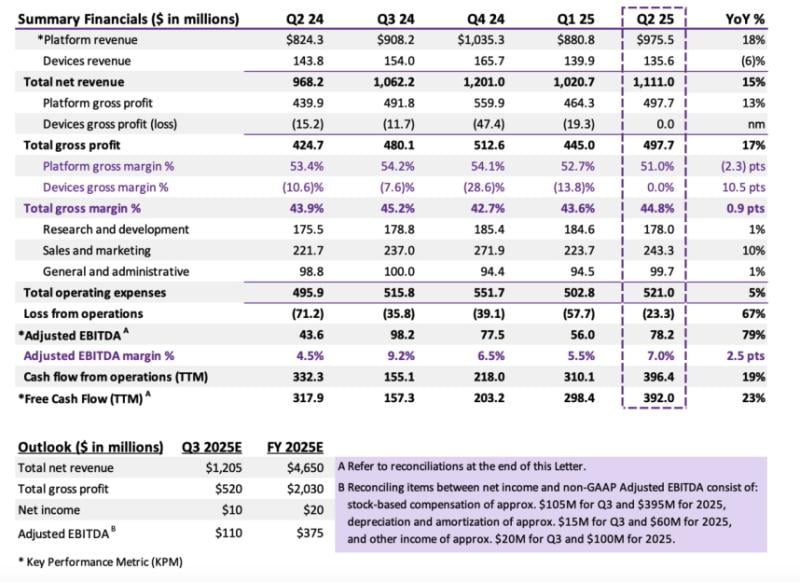Roku beat expectations in the second quarter with 15% revenue growth to $1.111 billion. The bigger surprise, however, was the streaming company’s return to profitability, its first swim in black ink (reporting $10.5 million in net income) since a six-quarter stretch from mid-2020 through all of 2021, when its stock price was more than four times higher than it is today.
Streaming hours on the Roku platform were also up 14.6% to 35.4 billion.
Driving the big quarter was, as usual, Roku’s platform business, which saw 18% revenue growth to $975.5 million in Q2. Speaking to equity analysts Thursday, Roku Co-Founder and CEO Anthony Wood said the breakout platform performance dates back to a strategic pivot made 18 months ago, when Roku began seeking out a more diversified revenue portfolio spread across large, third-party advertisers, small-business advertisers driven by the AI-powered Roku Ads Manager initiative launched last year, and growth of the company’s share of premium subscription sales on the Roku platform.
Also speaking during Thursday’s call, Roku media chief Charlie Collier drilled down specifically on the Ad Manager platform, noting that it “democratizes television,” The tool — which is designed to ease and streamline the process of creating and running TV commercials for smaller businesses — “opens up television to hundreds of advertisers you’d otherwise wouldn’t see,” Collier added.
Deeper integration into demand side platform (DSP) operators including The Trade Desk is also propelling Roku’s platform largesse, Wood said. Roku recently expanded its DSP integration, entering into deals with Amazon and vendor Wurl, both of which should starting bearing fruit later this year.
Roku is also still digesting Frndly, the virtual MVPD it bought over the spring for $185 million.
And usage of the Roku home screen as a key monetization driver has also helped with platform growth. Notably, Roku raised its full-year 2025 outlook for platform revenue to $4.075 billion.

Roku’s stock price peaked in July 2021 at just over $473 a share, just after the company reported epic 82% platform expansion for the second quarter of that year. But the company’s ability to sustain that growth faltered. By the first quarter of 2023, Roku’s platform business had slipped all the way into narrow recession, declining 1%, and the company’s stock price had cratered to below $53 a share right along with it.
Roku doesn’t make its bones anymore by making and selling streaming gadgets like smart TVs and hockey pucks — device revenue actually declined in Q2 by 6% to $135.6 million. For some time now, selling Roku hardware has mainly been about expanding the number of users who help monetize the Roku platform.
Roku didn’t talk Thursday about the challenges affecting that side of its business — specifically, its biggest retail distributor, Walmart, which reportedly may be shoving Roku aside and making its recently closed $2.3 billion acquisition of Vizio and its TVOS the foundation of its in-house smart TV brand.
With its refocused monetization strategy, Roku has generated platform revenue expansion of 15% or higher for four consecutive quarters. Wood believes a turnaround should be lasting.
Even if Roku isn’t able to make headway against platform rivals Samsung, Alphabet and Amazon in less infiltrated regions like Western Europe, he said, it could maintain double-digit platform growth for years to come simply by maintaining its leading position in the U.S. TVOS market, "with over half of U.S. broadband households using Roku devices."
A previous version of this article incorrectly described Wood's comments around Roku's TVOS position in the US as saying the company controls more than half of the connected TV streaming that goes on in broadband households. To avoid potential confusion around consumption versus device footprint, the article has been updated with Wood's direct quote, which says over half of US broadband households use Roku devices.